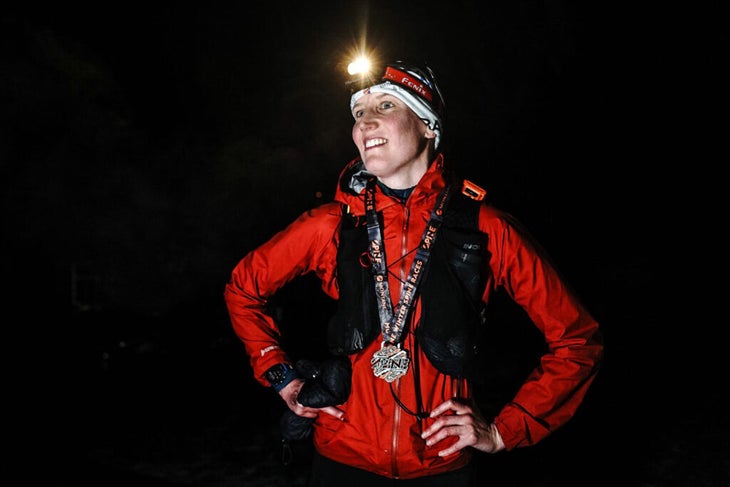“], “filter”: { “nextExceptions”: “img, blockquote, div”, “nextContainsExceptions”: “img, blockquote, a.btn, a.o-button”} }”>
New perk: Easily find new routes and hidden gems, upcoming running events, and more near you. Your weekly Local Running Newsletter has everything you need to lace up!
>”,”name”:”in-content-cta”,”type”:”link”}}”>Subscribe today.
Running a cold-weather trail race is a daunting prospect—especially if it’s an ultra-distance race.
But it can also be a fun, adventurous challenge that brings plenty of satisfaction, as long as you prepare for the wintry conditions. Just ask the winners of this year’s Winter Spine Sprint Race, which sent runners on a cold and snowy 46-mile ramble along England’s spiny mountain backbone—aka The Pennine Way—on January 11.
With temperatures hovering between 25 and 35 degrees Fahrenheit, cold winds, deep snow drifts, endless frozen uphills, and plentiful ice to contend with, the Spine Sprint exposed runners to the full ferocity of some of the United Kingdom’s most inhospitable weather.
If you’re gearing up for a trail race or long winter training run—or looking to refine your approach to winter running—consider this year’s Spine Sprint winners Paul Brennan and Hannah Bruce as the test subjects in your quest to successfully manage cold-weather conditions and slippery winter terrain.
Brennan, a 39-year-old cardiology consultant, has competed in Spartan races and mountainous trail ultras, including a second place finish in the UTMB Seven Sisters Skyline 55K race in 2023. With most of his experience in summer races, the Spine Sprint was an opportunity for him to test himself on one of Britain’s toughest and most scenic winter courses.
Bruce, a 36-year-old anesthetist who works for the National Health Service, has been running since she was in high school, transitioning to ultras during the Covid-19 pandemic in 2020. The Spine was her fourth ultra overall, but only her second in winter conditions.
“I just wanted to finish,” she says. “I knew I could do the distance, but could I look after myself in bad weather? Could I make good decisions? Could I do all this stuff, navigate, and get myself to the finish?”
Finish they did. Following smart strategies for gear, fueling, and racing, Brennan covered the snowy course in 9 hours, 26 minutes, while Bruce was the fastest woman in 12:53. That’s a long day of racing in the cold, to be sure, but even more grueling was the concurrent multi-day, 268-mile Winter Spine Race—which was won, respectively, by Kim Collison (82 hours, 46 minutes) and Lucy Gossage (87:41).
You might never do something so extreme in the winter, but here are some of their key takeaways that you can apply to your own winter running.
Tips for Cold-Weather Trail Running
Adjust for the snow
There’s nothing quite like snow to slow your race down. For Brennan, the men’s Winter Spine Sprint Race winner, the key is to keep moving at a steady, but manageable pace.
“When running in snow, taking a few percent off your max effort will avoid too much lactic build up and be more beneficial than trying to blast through it,” he says. “Your slow jog in these conditions is still going to be twice as fast as a walking pace. It’s about finding your cruise control pace, and just surviving and getting it done.”
Brennan went out at—and maintained—a heart rate at the lower end of Zone 3 to the higher range of Zone 2—a pace he calls a “6 out of 10 effort.”
“For me, that would typically be around 140 beats per minute,” he says. “This allows you to not use up your stores too fast, to get blood to your legs and, importantly, your stomach. If you try to blast through the snow, you’re going to end up in higher heart rate zones and burn out that much faster.”
Bruce took a different approach.
“I probably went off a bit too hard,” she admits. “The snow made it feel like a winter adventure. I think the pressure of being in the lead early contributed to me being a bit quick at the start.”
Having gone out so hard, Bruce says by the end she just wanted the race to be over. Her advice is to go out at a moderate pace and keep it steady instead, and you might actually enjoy your race, as well as finishing, even more.
RELATED: The Best Women’s Winter Running Apparel 2025
RELATED: The Best Men’s Winter Running Apparel 2025
Be adaptable
Because Brennan had a plan, he was able to veer from it in a controlled manner, if needed.
With the last hill out of the way and the finish line in sight, he knew only an injury could slow him down. “That’s when it became psychologically even harder, because the next 10K (6.2 miles) went by so slowly,” he says.
Instead of speeding up, Brennan worked with the terrain, slowing down to power-walk through 500 meters of powder, before gunning the final road climb, crossing the finish line in first place.
RELATED: Winter Running Tips to Keep You Motivated All Season
Mind your feet
Running in snow means you often can’t see your feet. Or the trail. In the mountains, this can be fatal.
About halfway through the Spine Race, just past a point called Bleaklow Hill, Brennan met a relatively flat single track, with a steep drop to the right. “There was nothing compact,” he says. “A fall to the right would have been fatal. It was the toughest section, without a doubt.”
Keeping a focus on narrow steps with a greater stride rate may just have saved his life.
Also, make sure your feet don’t get too cold. Excessive cold can lead to reduced feeling and control, and ultimately frostbite.
Poles or no poles?
Running poles have their place on winter trail runs, but they can become bogged down in loose powder—partly because you can’t see the terrain where you’re planting the tips. In some sections, Bruce found herself hefting her poles out of a few feet of snow with every step, unnecessarily sapping her energy.
It’s for that reason that Brennan never uses them. “If you do use poles, try not to be too fixated on them,” he says. “They can misguide you, and you could easily put a pole over the side of the route—like on this right hand drop off—and lose your balance.”
Keep moving to stay warm
It sounds obvious, but the easiest way to stay warm is to keep moving—even if it means moving at a slower pace than you intended. If you stop moving, you run the risk of getting chilled, reducing the impacts of the warm microclimate between your skin and base layer.
Likewise, go too hard and you’ll run the risk of getting too sweaty. Too much sweat trapped beneath insulating layers of clothing can create a chilly, wet layer against your skin.
“It goes back to finding a pace that allows you to move efficiently,” says Brennan. “The second you stop, you instantly will cool down.”
Stoke the fire
We need food for energy, and to stay warm. In a cold-weather trail race, eating properly is crucial for both.
“We burn different types of fat in cold weather and if you’re not well-fueled, your body will start breaking your fat stores down,” Brennan warns.
This means that your blood supply will be thrown out of whack, as will your metabolic rates, resulting in you getting colder, quicker.
Another danger in this is having a lack of blood to your gastric organs, messing up your digestion—something Bruce experienced first hand after experiencing stomach pains early on, then throwing up twice and, as a result, not eating for the final four hours of the race.
“Aim for at least 60 grams of carbohydrate per hour, at the very least,” Brennan advises.
Brennan favors ginger cake with butter alongside gels, powders and energy bars—plus the odd aid station lucky dip of whatever’s available. For her race, Bruce packed a package of banana-flavored energy snacks, two candy bars, and some gummy sweets.
But don’t neglect your macros. “We focus on carbs, but you still need to take on protein to compensate for muscle breakdown,” Brennan adds.
Don’t forget your spikes
Bruce ran in a pair of Inov-8 Trailtalon trail running shoes, but when the terrain got slippery she slipped on a set of Kahtoola Microspikes. The added traction helped keep her footing going uphill, and on ice. But because putting on and taking off traction can be a real hassle, Brennan advises donning them from the start, and keeping them on.
While you can sometimes get by running through snow and slush just by wearing trail running shoes with knobby outsole lugs, there are three primary ways to improve your traction for winter running on snowy and icy wintry surfaces, ranging from affordable to relatively expensive. You can buy running crampons that slip over your shoes or you can modify your existing shoes for better traction on ice by inserting screws around the perimeter of the outsole. Or you can invest in a pair of winter running shoes that come with tiny spikes embedded in the outsoles.
RELATED: Three Smart Options to Enhance Traction for Winter Running
Interpret the gear list
Some cold-weather trail races—like some warm-weather trail races—have a mandatory gear list for a reason: it might just save your life.
The Spine Sprint gear list necessitates a sleeping bag with a rating of zero degrees Celsius (or 32 degrees Fahrenheit) or colder, as well as a waterproof bivy bag. Those items might not be used until you need to hunker down and need them for warmth, but Brennan says expensive options can freeze out runners without sponsors.
“I’m a gear mongrel,” he says. “At one end of the race spectrum, there’ll always be people who want the best of the best. But if you can get a more affordable version that does the same job [and falls within the rules] that’s fine.”
He recommends checking Facebook Marketplace or Instagram groups for good second-hand gear.
And, do make sure your backpack fits comfortably before embarking on a run—Bruce says she made the mistake of wearing one that was too large. Not only did it bruise her back, she had to run the last 30K (18.6 miles), with one hand behind her back, holding it out of the way.
RELATED: Winter Running: Advice From the World’s Coldest Places
Keep your feet warm with cold-weather trail shoes
Brennan opted for Hoka Tecton X3s, primarily because they have gators which will stop you getting snow in your shoes, are light, and with the addition of spikes, the relatively short 4-millimeter lugs become redundant. Shoes with a waterproof lining can keep the cold conditions and wet, slushy snow at bay, but your feet can also overheat and sweat, which can ultimately make your them colder over long durations.
Many trail runners wear wool socks in the winter, because wool provides excellent insulation and moisture-wicking properties and can continue to keep your feet warm, even if they get wet.
“I use standard sports compression socks, not waterproof socks,” Brennan says. “Everyone’s different but I think if you get wet, and your socks don’t breathe, you’re going to sweat even more, and your feet will stay wet, even in waterproof socks.”
A breathable, moisture-wicking merino wool or synthetic base layer top, and long, water-resistant running pants are also a must, as is a light down mid layer underneath a waterproof, breathable jacket, like the Montane Phase Nano GORE-TEX Waterproof Jacket.
Be bothered
When it comes to your gear, the key thing Bruce learned was: “You’ve got to be bothered.” In other words, as soon as something bothers you, do something about it. Feel cold? Put your coat on. Starting to rain? Make sure you have your waterproof gear on, to avoid getting the base layers wet. Hungry? Eat something. Can’t see well, put on clear glasses.
But it’s different for everyone, so you need to know your limits and the conditions. Rebecca Deveroux, the third-place female finisher representing the Black Trail Runners, took a slightly different approach, running the entire race in shorts. “Seeing everyone in full winter kit at the start line, I briefly questioned my decision,” she says. “But I always run hot, and I knew I had extra kit if needed. In the end, the conditions made moving such hard work I was never cold!”
Connect with the community
If you’re running your first winter race, it might be easy to become overwhelmed by snow, wind, and ice. For Brennan, it’s important to stay focused, and to keep it fun. Trail running is all about community, and it takes a village to get through any long event—especially in adverse wintry conditions and extremely cold temperatures.
“It was a pretty lonely race, so I try to say hello to everyone I pass,” he explains. In the spirit of keeping it light, he cracked a joke to a few of the other runners, and promptly fell on his ass. “I slipped on my backside and went skidding down the hill, much to their amusement,” he says.
For Bruce, a running mate met along the trail helped push her over the line when her stomach issues almost forced her to stop.
“I should give credit to Duncan Hudson,” she says. “One of the best things about this race is the community; people sticking together and helping each other out when it’s really hard.”
Brennan, realizing he had the lead early on, gave himself a motivating pep talk. “I thought ‘Oh, this is on me,’” he remembers. “I haven’t won a race before. This is about mindset now, and I’m not accepting anything less [than a win].”
It was a mental game as much as anything. Apart from at the very end, he forced himself to stay at a set speed, focusing on other variables like his fuel, staying on track, and avoiding injury.
“Run focused, not excited,” he says.
Follow the trail
When running a winter trail race, you need to stay on track—literally and metaphorically.
The Spine Sprint is self-supported, meaning the route is not marked, with runners needing to navigate via Garmin or other GPS devices—that is, when the Garmins aren’t frozen from the cold.
“There was a group of us who got lost,” Bruce admits. “We couldn’t find the path on Bleaklow Peak because of the snow. We were stuck together, trying to find the route.”
By keeping calm, they eventually managed to find the route, and Bruce secured her first win.
If you’re stuck in the snow for longer, Brennan advises you get wrapped up as soon as you can, and get help as soon as you can. “When you’re truly isolated, it can go wrong very fast,” he says. “Don’t panic, with watches, GPS trackers, and maps, there’s usually a way to find your way back – but there’s little to be gained by trying to survive and await rescue in wilderness conditions if you’re not trained for it.”

Prepare wisely
“Running in bad weather over and over again in the lead up to the race meant I was ready, mentally and physically,” Bruce says. “I went out on the Pennine Way a few weeks ago, in a storm with a 50 mile-an-hour head wind. It was so strong that I couldn’t run into it. If I turned my body, it became a cross-win, blowing me off the path.”
During the actual race, the windchill factor was comparatively balmy, just 20 degrees. Piece of cake.
RELATED: Why Runners Should Treat Winter as a Training Tool











![News For The Run: Coaches Hired & Fired! + AFC/NFC Championship Predictions! [3/3 on Ep.196] News For The Run: Coaches Hired & Fired! + AFC/NFC Championship Predictions! [3/3 on Ep.196]](https://5amrunmag.com/wp-content/uploads/2025/05/1747010371_maxresdefault-75x75.jpg)


